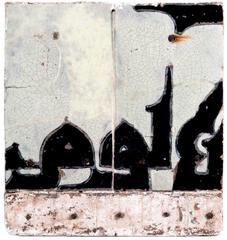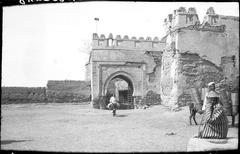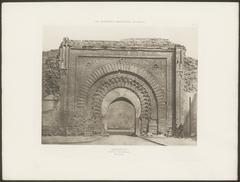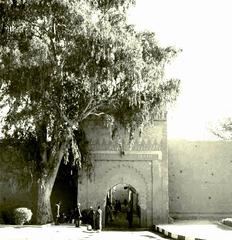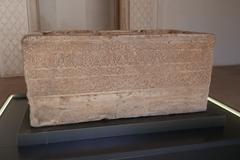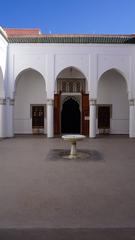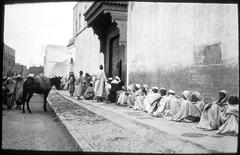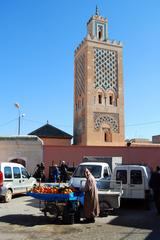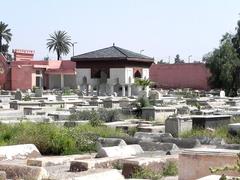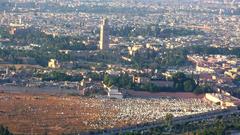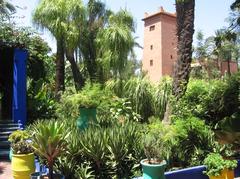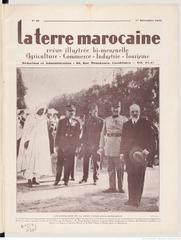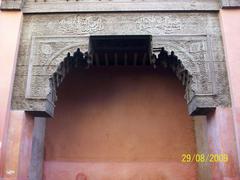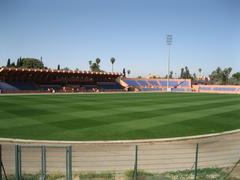Complete Guide to Visiting Jemaa el-Fnaa Marrakesh: History, Visitor Tips, and More
Date: 25/07/2024
Introduction
Jemaa el-Fnaa, located in the heart of Marrakesh, Morocco, is one of the most iconic and historically significant public squares in the world. Designated as a UNESCO World Heritage Site, this bustling marketplace has been a central hub for trade, social interaction, and cultural exchange for centuries. Marrakesh itself was founded in 1070 by the Almoravid dynasty, and Jemaa el-Fnaa quickly emerged as a focal point of the city’s vibrant life (Lonely Planet). The square is renowned for its dynamic atmosphere, especially in the evenings when it transforms into a vibrant scene filled with food stalls, street performers, and entertainers (Planetware).
Visitors to Jemaa el-Fnaa can expect a sensory overload, from the aromatic spices and sizzling meats to the captivating sounds of traditional Moroccan music and the sight of snake charmers and henna artists. The square is a melting pot of culture, where locals and tourists alike can experience the rich heritage of Marrakesh. To fully appreciate the historical and cultural context of Jemaa el-Fnaa, it is recommended to explore the surrounding souks, historical sites, and landmarks that contribute to its unique charm (Katie Caf Travel).
In this comprehensive guide, we will delve into the origins and early history of Jemaa el-Fnaa, its architectural influence, role in trade and commerce, cultural and religious significance, and notable historical events and figures associated with the area. Additionally, we will provide practical tips for visitors, including the best times to visit, navigating the square, safety precautions, food and drink recommendations, shopping tips, cultural etiquette, and more. Whether you are a history enthusiast, a foodie, or simply a curious traveler, this guide will equip you with everything you need to know for a memorable experience at Jemaa el-Fnaa.
Table of Contents
- [Origins and Early History](#origins-and-early-historyorigins-and-early-history)
- [Architectural Influence](#architectural-influencearchitectural-influence)
- [Role in Trade and Commerce](#role-in-trade-and-commercerole-in-trade-and-commerce)
- [Cultural and Religious Significance](#cultural-and-religious-significancecultural-and-religious-significance)
- [Historical Events and Figures](#historical-events-and-figureshistorical-events-and-figures)
- [Preservation and Modern-Day Relevance](#preservation-and-modern-day-relevancepreservation-and-modern-day-relevance)
- [Visitor Tips](#visitor-tipsvisitor-tips)
- [Best Times to Visit Jemaa el-Fnaa](#best-times-to-visit-jemaa-el-fnaabest-times-to-visit-jemaa-el-fnaa)
- [Navigating Jemaa el-Fnaa](#navigating-jemaa-el-fnaanavigating-jemaa-el-fnaa)
- [Safety and Scams](#safety-and-scamssafety-and-scams)
- [Food and Drink](#food-and-drinkfood-and-drink)
- [Shopping Tips](#shopping-tipsshopping-tips)
- [Cultural Etiquette](#cultural-etiquettecultural-etiquette)
- [Accommodation](#accommodationaccommodation)
- [Transportation](#transportationtransportation)
- [Health and Safety](#health-and-safetyhealth-and-safety)
- [Language and Communication](#language-and-communicationlanguage-and-communication)
- [Photography Tips](#photography-tipsphotography-tips)
- [Relaxation Spots](#relaxation-spotsrelaxation-spots)
- [Local Experiences](#local-experienceslocal-experiences)
- [Special Events and Guided Tours](#special-events-and-guided-toursspecial-events-and-guided-tours)
- [Frequently Asked Questions (FAQ)](#frequently-asked-questions-faqfrequently-asked-questions)
Origins and Early History
Jemaa el-Fnaa has roots that trace back to the early days of Marrakesh’s establishment. Founded in 1070 by the Almoravid dynasty, Jemaa el-Fnaa quickly emerged as a significant location. The Almoravids were known for their architectural and cultural contributions, which laid the groundwork for Marrakesh’s development as a major urban center.
Architectural Influence
The architectural style of Jemaa el-Fnaa reflects the intricate designs and craftsmanship characteristic of the Almoravid and subsequent Almohad periods. Traditional Moroccan elements such as zellige tilework, carved stucco, and cedar woodwork adorn the site. These elements are not only aesthetically pleasing but also serve as a testament to the advanced engineering and artistic skills of the time.
Role in Trade and Commerce
During the height of the Almoravid and Almohad dynasties, Marrakesh was a bustling hub of trade and commerce. Jemaa el-Fnaa played a crucial role in this economic activity. Located strategically near the medina, it served as a marketplace where traders from across North Africa and beyond would converge. Goods such as spices, textiles, and precious metals were commonly traded, making Jemaa el-Fnaa an essential part of Marrakesh’s economic landscape.
Cultural and Religious Significance
Jemaa el-Fnaa is not just a commercial site; it also holds cultural and religious importance. The area is home to several small mosques and madrasas (Islamic schools), which were established to serve the local community. These institutions were centers of learning and religious practice, contributing to the spread of Islamic teachings and culture in the region.
Historical Events and Figures
Over the centuries, Jemaa el-Fnaa has witnessed numerous historical events and has been associated with several notable figures. One significant event is the Battle of Marrakesh in 1147, where the Almohads defeated the Almoravids, leading to significant changes in the city’s governance and architecture. Prominent figures such as Ibn Tumart and Yacoub el-Mansour have connections to the area, influencing its development and cultural landscape.
Preservation and Modern-Day Relevance
In recent years, efforts have been made to preserve the historical and cultural heritage of Jemaa el-Fnaa. Restoration projects have been undertaken to maintain the architectural integrity of the site, ensuring that future generations can appreciate its historical significance. These efforts are supported by both local authorities and international organizations dedicated to cultural preservation.
Today, Jemaa el-Fnaa continues to be a vibrant part of Marrakesh, attracting tourists and history enthusiasts alike. Its rich history and cultural significance make it a must-visit location for anyone interested in exploring the depths of Marrakesh’s past.
Visitor Tips
Best Times to Visit Jemaa el-Fnaa
The best times to visit Marrakesh are from March to May and late September to November. During these periods, the weather is dry and warm, with daily high temperatures ranging from 23 to 30 degrees Celsius. This makes it ideal for exploring the bustling streets and markets of Jemaa el-Fnaa without the discomfort of extreme heat. In contrast, summer temperatures can soar up to 40 degrees Celsius, making it quite challenging to enjoy outdoor activities (Anywhere We Roam).
Navigating Jemaa el-Fnaa
Jemaa el-Fnaa is the heart of Marrakesh and a UNESCO World Heritage Site. It is a bustling square filled with food stalls, entertainers, and vendors. To make the most of your visit, it’s essential to be prepared for the sensory overload. The square comes alive in the evening, so plan your visit around sunset to experience its full vibrancy. During the day, it’s a bit quieter, making it a good time for shopping and exploring without the crowds (Katie Caf Travel).
Safety and Scams
Marrakesh, like many tourist destinations, has its share of scams. Be cautious of anyone approaching you on the street offering unsolicited help or directions. Often, these individuals are touts looking to earn money from tourists. Politely decline their offers and continue on your way. If you need assistance, it’s better to ask shopkeepers or staff at your accommodation (Katie Caf Travel).
Food and Drink
Jemaa el-Fnaa is famous for its street food. From roasted sheep’s head to fresh juice and escargot, the variety is astounding. However, it’s essential to be cautious about food hygiene. Opt for stalls that are busy with locals, as this is usually a good indicator of quality and safety. Additionally, always drink bottled water to avoid any stomach issues (Katie Caf Travel).
Shopping Tips
The souks around Jemaa el-Fnaa are a shopper’s paradise, offering everything from spices to textiles. Haggling is expected, so don’t be afraid to negotiate prices. Start by offering about half of the initial asking price and work your way up. It’s also a good idea to carry small denominations of the local currency, Dirhams, to make transactions smoother (The Talking Suitcase).
Cultural Etiquette
Respecting local customs and traditions is crucial when visiting Marrakesh. Dress modestly, especially when visiting religious sites. Women should cover their shoulders and knees, and men should avoid wearing shorts. Additionally, always ask for permission before taking photos of people, particularly in Jemaa el-Fnaa, where performers may expect a tip in exchange for photographs (Lonely Planet).
Accommodation
Staying in a riad, a traditional Moroccan house with an interior garden or courtyard, can enhance your Marrakesh experience. Riads offer a more authentic and intimate setting compared to hotels. Some recommended riads include Riad Farnatchi, which features a spa and private Hammam, providing a luxurious retreat after a day of exploring (Anywhere We Roam).
Transportation
Navigating Marrakesh can be challenging due to its labyrinthine streets. Taxis are a convenient way to get around, but always agree on a fare before starting your journey to avoid being overcharged. Alternatively, consider using the local bus system, which is budget-friendly and efficient. For those who prefer a more guided experience, numerous day tours are available that cover the main attractions (Casual Travelist).
Health and Safety
Travel insurance is highly recommended when visiting Marrakesh. It can cover unexpected medical expenses, trip cancellations, and other unforeseen events. Additionally, be mindful of your belongings, as pickpocketing can occur in crowded areas like Jemaa el-Fnaa. Use a money belt or a secure bag to keep your valuables safe (The Travel Hack).
Language and Communication
While Arabic is the official language, French is widely spoken in Marrakesh. Learning a few basic phrases in either language can go a long way in enhancing your interactions with locals. English is also understood in tourist areas, but it’s always appreciated when visitors make an effort to speak the local language (Lonely Planet).
Photography Tips
Jemaa el-Fnaa offers countless photo opportunities, from the vibrant market stalls to the captivating street performers. For the best shots, visit during the golden hour, just before sunset. Be respectful when photographing people and always ask for permission. Some performers may expect a small tip in exchange for allowing you to take their picture (Anywhere We Roam).
Relaxation Spots
Amidst the hustle and bustle of Jemaa el-Fnaa, finding a quiet spot to relax can be a welcome respite. The Majorelle Garden, a short distance from the square, offers a peaceful escape with its lush greenery and vibrant blue buildings. Another option is to visit one of the many rooftop cafes around the square, where you can enjoy a mint tea while taking in panoramic views of the city (Morocco Trailblazer).
Local Experiences
To truly immerse yourself in the local culture, consider participating in a cooking class or a guided food tour. These experiences offer a hands-on way to learn about Moroccan cuisine and traditions. Additionally, visiting a traditional Hammam can provide a unique insight into local customs and offer a relaxing way to unwind (Katie Caf Travel).
Special Events and Guided Tours
Jemaa el-Fnaa hosts a variety of special events throughout the year, including traditional music performances and cultural festivals. Guided tours are also available and can provide deeper insights into the history and significance of the square. Booking a guided tour can ensure you don’t miss any of the key attractions and can provide a more enriching experience.
Frequently Asked Questions (FAQ)
Q: What are the visiting hours for Jemaa el-Fnaa?
A: Jemaa el-Fnaa is open 24 hours a day, but the best times to visit are in the evening when the square is most vibrant.
Q: How much do tickets cost for Jemaa el-Fnaa?
A: There is no entrance fee to visit Jemaa el-Fnaa. However, some attractions and activities within the square may charge fees.
Q: Are guided tours available at Jemaa el-Fnaa?
A: Yes, guided tours are available and highly recommended to enhance your understanding of the square’s historical and cultural context.
Q: What nearby attractions should I visit?
A: Nearby attractions include the Koutoubia Mosque, the Saadian Tombs, and the vibrant medina of Marrakesh.
Q: Can I take photographs at Jemaa el-Fnaa?
A: Yes, photography is allowed, but be respectful and avoid taking pictures of people without their permission.
Conclusion
Jemaa el-Fnaa stands as a testament to the rich history and cultural vibrancy of Marrakesh. From its origins in the 11th century to its modern-day status as a bustling marketplace and UNESCO World Heritage Site, the square encapsulates the essence of Moroccan life. Visitors can immerse themselves in the dynamic atmosphere, savor traditional street food, and witness captivating performances that have been part of the square’s heritage for centuries (Anywhere We Roam).
Exploring Jemaa el-Fnaa offers a unique opportunity to experience the confluence of history, culture, and commerce. The square’s architectural elements, influenced by the Almoravid and Almohad periods, showcase the advanced engineering and artistic skills of the time (Lonely Planet). Its role as a hub for trade and commerce has shaped the economic landscape of Marrakesh, making it an essential part of the city’s identity.
As visitors navigate the vibrant souks and historical landmarks surrounding Jemaa el-Fnaa, they are not only witnessing the present-day allure of the square but also connecting with its storied past. By following the practical tips provided in this guide, such as visiting during the optimal seasons, respecting local customs, and being mindful of safety precautions, travelers can ensure a respectful and enriching experience.
In conclusion, Jemaa el-Fnaa is more than just a marketplace; it is a living, breathing embodiment of Marrakesh’s rich heritage and cultural diversity. Whether you are drawn to its historical significance, culinary delights, or lively atmosphere, a visit to Jemaa el-Fnaa promises an unforgettable journey into the heart of Moroccan culture. For more information and to stay updated on Jemaa el-Fnaa, consider downloading our mobile app Audiala, checking out related posts, or following us on social media.
References
- Lonely Planet. (n.d.). Morocco: Marrakesh. Retrieved from Lonely Planet
- Planetware. (n.d.). Tourist Attractions in Marrakesh. Retrieved from Planetware
- Katie Caf Travel. (n.d.). Travel Tips for Marrakesh, Morocco. Retrieved from Katie Caf Travel
- Anywhere We Roam. (n.d.). Things to Do in Marrakesh. Retrieved from Anywhere We Roam
